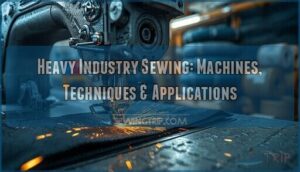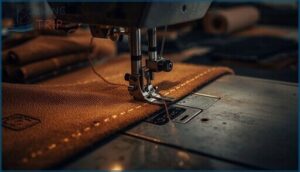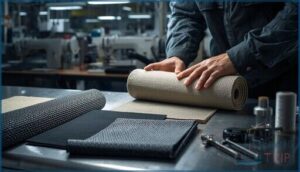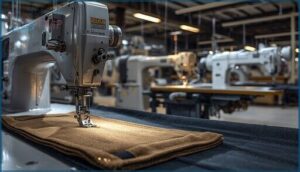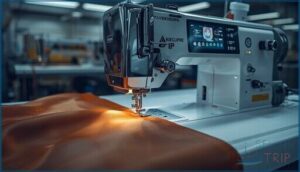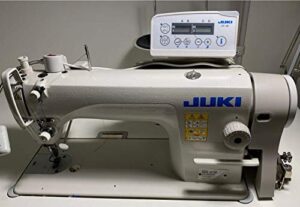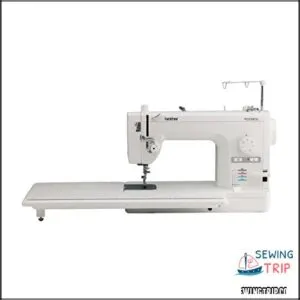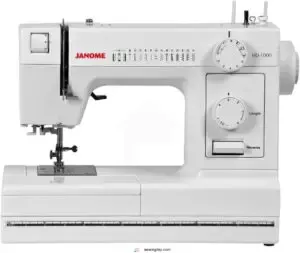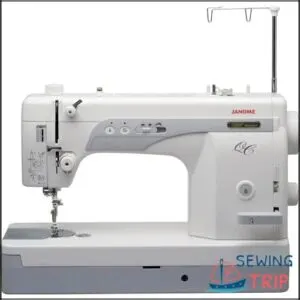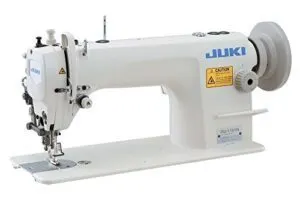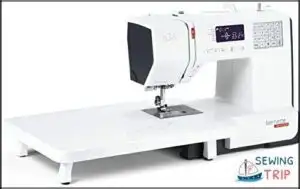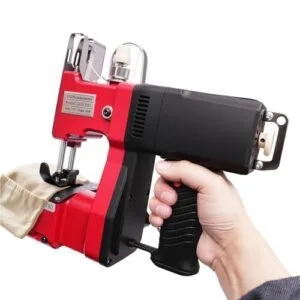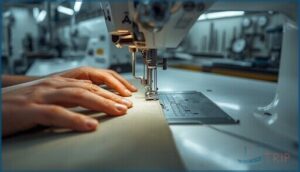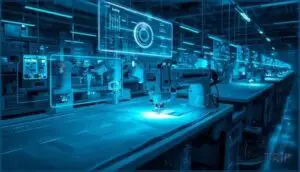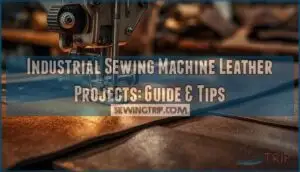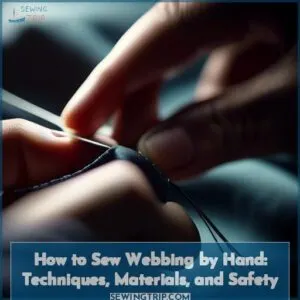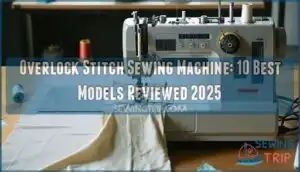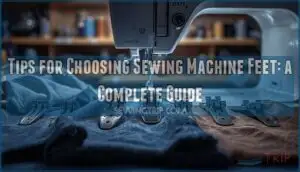This site is supported by our readers. We may earn a commission, at no cost to you, if you purchase through links.
Most people think industrial sewing just means bigger machines and thicker thread, but that’s like saying a jet engine is just a larger fan. When you’re stitching seat belts that anchor human bodies during 60-mph impacts or manufacturing surgical gowns that can’t fail mid-procedure, you’re operating in a different universe entirely.
Heavy industry sewing transforms raw technical textiles into load-bearing structures through machines that deliver over 5,000 precision stitches per minute—machines built with cast-iron frames specifically engineered to prevent the microscopic vibrations that would compromise seam integrity across millions of repetitions.
The gap between your home sewing machine and these industrial workhorses isn’t just scale; it’s the difference between crafting and engineering, between hobby projects and products where failure isn’t an option.
Table Of Contents
- Key Takeaways
- What is Heavy Industry Sewing?
- Essential Industrial Sewing Techniques
- Industrial Sewing Vs. Welding
- Choosing The Right Industrial Sewing Machine
- Top 7 Heavy Industry Sewing Machines
- Best Practices in Industrial Sewing Operations
- Automation and Technological Advancements
- Sustainability and Labor in Heavy Industry Sewing
- Frequently Asked Questions (FAQs)
- Conclusion
Key Takeaways
- Heavy industry sewing operates at engineering-grade precision with machines delivering 5,000+ stitches per minute through cast-iron frames designed to handle load-bearing seams in materials like ballistic nylon, where failure isn’t an option—this isn’t scaled-up hobby work, it’s manufacturing infrastructure for products from seat belts to surgical gowns.
- Your choice between sewing and welding hinges on breathability and material compatibility: sewn seams achieve 50-77% fabric tensile strength but maintain air permeability and flexibility across mixed materials, while welded seams hit 100% strength on thermoplastics but eliminate breathability—making sewing the go-to for protective wear, multi-layer assemblies, and any application where natural movement matters.
- Machine selection demands matching capability to workload through key specs: walking foot systems grip layered materials without slippage, servo motors slash energy consumption by 70% while hitting production speeds, and automation features like IoT connectivity and predictive maintenance cut unplanned downtime by 30% when you shift from reactive repairs to prevention-based workflows.
- The industry faces a sustainability-labor collision where 8-10% of global CO₂ emissions stem from textile manufacturing while 415,000 unfilled jobs and a 20% worker shortage intensify—solutions require both material innovation like recycled PET threads that cut raw material demand 30% and workforce programs that train operators in hybrid technical-digital competencies traditional pipelines can’t deliver fast enough.
What is Heavy Industry Sewing?
Heavy industry sewing isn’t your typical home machine work—it’s the backbone of manufacturing operations that demand serious power and precision. When you’re working with thick tarps, industrial filters, or commercial upholstery, you need equipment and techniques designed to handle materials that would jam a household machine in seconds.
Let’s break down what separates heavy industry sewing from standard operations, the core characteristics that define this field, and where you’ll find it making an impact across manufacturing sectors.
Definition and Core Characteristics
Heavy industry sewing joins technical textiles—like ballistic nylon and multi-ply canvas—using industrial sewing machines built for continuous operation. You’re working with heavy-duty materials that demand needle sizes between 110 and 125, stitch rates exceeding 1,000 per minute, and cast-iron frames that won’t quit.
This isn’t standard fabric selection; it’s industrial manufacturing engineered for load-bearing seams and environmental durability specifications. Industrial sewing applications often require custom sewing solutions to guarantee precision and strength in every product.
Key Differences From Regular Sewing
Speed comparison reveals the gap immediately: your industrial machine runs at 5,000 stitches per minute—nearly five times a domestic model’s 1,100. Material capacity extends to 5 mm stacked thickness in leather or canvas, while home units struggle beyond 2 mm.
Machine durability shows in 15-year lifespans processing over 20 million stitches. That operational efficiency and industrial strength sewing define the divide between hobby work and heavy-duty textile manufacturing.
Industrial machines are preferred for heavy duty sewing due to their high speed and powerful motors.
Industries and Applications
That operational muscle powers diverse industrial sewing applications across sectors you mightn’t expect. Apparel manufacturing claims over 53% of the global market, but heavy-duty textile applications extend far beyond fashion.
- Automotive interiors—seat covers, airbags, and headliners demand precision stitching on industrial fabric
- Medical textiles—surgical gowns and masks require exacting contract sewing standards
- Tarpaulin production and upholstery applications—reinforced seams for outdoor durability and textile products built to last
Essential Industrial Sewing Techniques
Every stitch type you’ll use in heavy industry sewing fills a specific purpose, and knowing when to reach for each one separates skilled operators from beginners. Your choice affects everything from seam durability to how the finished product withstands stress.
Here’s a breakdown of the essential techniques you need in your arsenal.
Lockstitch, Chain Stitch, and Zigzag Stitches
When you’re selecting sewing techniques for industrial applications, understanding stitch strength comparison becomes your foundation.
Lockstitch delivers durability with reduced seam puckering—ideal for medium-weight fabrics. Chain stitch offers greater elasticity and applications in stretch materials, though failure mode analysis reveals it’s prone to unraveling.
Zigzag stitch’s multi-step construction distributes tension across seams, preventing breakage in active, load-bearing textiles.
Cover Stitches and Their Uses
Cover stitch technology gives you a powerful edge when working with heavy materials and industrial knitwear. This technique creates parallel rows on top with a zigzag looper underneath, delivering remarkable seam stretchability—up to 120% fabric extension without thread breakage.
You’ll find cover stitch essential for upholstery seaming and heavy-duty textile applications where abrasion resistance matters. The single-pass operation drives defect reduction while streamlining your industrial sewing techniques.
Reinforcement and Decorative Methods
Reinforcement techniques transform good industrial sewing into superior craftsmanship. When you’re working with heavy materials, these five methods deliver lasting durability:
- Bar tacks at strap attachments boost seam strength 25–40%
- Flat-felled seams withstand 500+ N tensile loads
- Seam taping creates liquid-tight PPE protection
- Edge binding prevents fraying on heavy-duty textile applications
- Topstitching reinforces while adding visual definition
Master these stitching patterns and your sewing techniques become unstoppable.
Industrial Sewing Vs. Welding
When you’re deciding how to join heavy-duty fabrics and materials, the choice between sewing and welding can make or break your project. Each method brings its own strengths to the table, from material compatibility to long-term durability and cost implications.
Let’s walk through the key factors that’ll help you determine which approach fits your specific manufacturing needs.
Material Compatibility and Product Needs
You can’t just match any thread to any fabric and hope for the best—thread-fabric pairing determines whether your seam holds or fails under pressure. Industrial sewing machines demand precision when working with heavy materials, from bonded nylon on tactical gear to PTFE threads for chemical-resistant tarps.
| Product Type | Recommended Thread & Fabric |
|---|---|
| Military Gear | Bonded nylon + Heavy canvas |
| Medical Bags | Polyester + Durable synthetics |
| Protective Tarps | PTFE/ePTFE + HDPE fabrics |
| Utility Harnesses | Bonded nylon + Heavy webbing |
| Equipment Cases | Tex 135 polyester + Dense canvas |
Your material choices directly impact seam strength, material lifespan, and environmental resistance. Heavy-duty textile applications require specialized equipment calibrated for heavy-duty fabric—needle size, thread thickness, and bonding all affect cost-effectiveness and long-term performance.
Strength, Flexibility, and Breathability
Welded seams might hit 100% fabric tensile strength, but sewn seams generally achieve 50-77% seam efficiency—yet they dominate heavy-duty textile applications where flexibility matters most. Your stitch density and material composition determine whether your product bends naturally or cracks under load.
| Performance Factor | Industrial Sewing | Fabric Welding |
|---|---|---|
| Seam Durability | 50-77% efficiency | Up to 100% efficiency |
| Load Capacity | 92 lbs+ (wool fabrics) | Higher static strength |
| Air Permeability | Maintains breathability | Eliminates breathability |
| Flexibility | Excellent drape/movement | Rigid, restricted |
| Heavy Materials | Multi-layer compatible | Thermoplastics only |
Industrial sewing machines excel when you’re working with non-thermoplastic heavy-duty fabric, multiple layers, or products requiring natural movement. Stitch density affects both seam strength and extensibility—tighter stitches increase load capacity but reduce flexibility. That’s why protective wear and medical textiles rely on sewn seams for thermal comfort, while waterproof gear demands welding’s airtight seal.
Cost and Equipment Considerations
Your initial investment in industrial sewing machines ranges from $300 for entry-level units to $20,000+ for fully computerized systems, while welding equipment often starts at $3,000 and climbs higher. However, sewing demands ongoing maintenance expenses—needles, thread, lubricants—that welding eliminates. Equipment lifespan averages 10-20 years for both, though intensive use shortens that window considerably.
| Cost Factors | Industrial Sewing | Fabric Welding |
|---|---|---|
| Initial Investment | $300-$20,000+ | $3,000-$25,000+ |
| Consumables | Thread, needles, lubricants | Minimal to none |
| Operator Training | Moderate complexity | Specialized certification |
Manufacturing efficiency drives sewing machine selection—you’ll balance upfront costs against long-term operational demands. Market trends show computerized systems dominating purchases despite higher prices, as automation cuts labor costs and boosts throughput. Specialized equipment maintenance becomes your hidden expense, requiring technical servicing that adds to operational budgets over your machine’s lifespan.
When to Choose Sewing Over Welding
Your fabric’s breathability demands drive the sewing decision—when air and moisture permeability matter, stitched seams outperform sealed welds every time. You’ll choose sewing for mixed materials that can’t be thermally fused, design complexity requiring intricate angles, and customization needs demanding quick prototyping. Cost-effectiveness shines in low-volume runs where sewing’s flexibility trumps welding’s automation advantages.
| Decision Factor | Choose Sewing When | Choose Welding When |
|---|---|---|
| Material Type | Non-thermoplastic, mixed fabrics | PVC, PU, polyethylene substrates |
| Breathability | Air/moisture permeability required | Airtight/watertight seals needed |
| Production Volume | Low-volume, custom batches | High-volume continuous runs |
| Design Needs | Complex shapes, decorative stitching | Simple geometries, uniform seams |
| Flexibility | Stretch and elasticity essential | Rigid, structural integrity priority |
Choosing The Right Industrial Sewing Machine
Picking the right industrial sewing machine isn’t about grabbing the biggest or most expensive option—it’s about matching capability to your actual workload. You need to assess what you’re sewing, how often you’re running it, and what features will actually move the needle on productivity and quality.
Let’s break down the key factors that’ll help you make a smart investment.
Assessing Fabric and Project Requirements
You’ll need to start by evaluating tensile strength and material selection for your project—whether you’re handling heavy-duty fabric for conveyor systems or lightweight textiles for filtration.
Assess operator performance requirements, quality standards, and current industry trends in textile product development.
Understanding fabric handling characteristics and heavy-duty textile applications ensures you select machinery that matches your heavy-duty fabric’s specific demands and production goals.
Machine Types: Walking Foot, Cylinder Arm, Etc
Once you’ve matched your fabric to the right specs, machine comparison becomes straightforward. Walking Foot systems grip material from top and bottom—perfect for heavy layered work. Cylinder Arm designs let you sew tubular items like sleeves and bags with precision. Here’s what sets each bed type apart:
- Walking Foot: Triple feed for slippery, multi-layer fabrics
- Cylinder Arm: Curved sewing on tight, tubular sections
- Post Bed: Ideal for shoe and bag construction
- Long Arm: Extends reach for quilting and wide panels
- Flat Bed: Standard workhorse for most industrial sewing machine types
Automation levels vary—computer-controlled models dominate at 26.5% of sales, while manual machines still handle specialized tasks.
Technical Specifications and Features
Look beyond bed style—stitch speed separates the pack. Top models hit 5,500 stitches per minute for production runs, while heavy-duty walking foot machines cap at 3,000.
Motor power generally lands between 400 and 550 watts, with servo models slashing energy use by 70%.
Automation features like thread trimming boost throughput 20%, and touchscreen user interfaces store 400+ patterns.
Material handling systems adapt presser foot pressure automatically, ensuring clean seams on thick or delicate textiles.
Environmental and Efficiency Considerations
Energy efficiency and waste reduction transform operational costs. Servo motors cut electricity consumption 30–50% versus clutch systems, while ISO 50001 compliance delivers 10–25% site-level savings. Pattern optimization software trims pre-consumer scrap by 2–5 percentage points.
Eco-friendly threading, LED retrofits, and sustainable materials align with green manufacturing targets.
Automation in sewing boosts production line efficiency, reduces rework, and advances sustainability in textiles—lowering your environmental impact of sewing without sacrificing throughput or industrial automation gains.
Top 7 Heavy Industry Sewing Machines
Choosing the right machine can make or break your production line, especially when you’re working with heavy-duty materials that demand precision and power. The market offers dozens of options, but only a handful truly deliver the reliability and performance you need for industrial-scale operations.
Here are seven machines that consistently prove themselves on factory floors around the world.
1. Juki Industrial Sewing Machine System
When you’re ready to dominate high-volume production lines, the Juki DDL87007 stands as a standard in industrial sewing machine types, commanding approximately 30% market share worldwide. You’ll find Juki features like direct drive servo motors delivering 5,000 stitches per minute while cutting energy use by 20%.
Automation integration through IoT connectivity and predictive maintenance systems transforms your factory floor efficiency. With 25,000 units deployed globally and proven sewing machine technology across continents, Juki’s sustainability efforts—including 1,329 tons of recycled waste—align performance with environmental responsibility in industrial sewing machines.
Best For: Large-scale manufacturers and industrial operations that need to handle high-volume production runs across a wide range of materials, from lightweight synthetics to heavy-duty canvas and leather.
- Blazing fast 5,000 stitches per minute with servo motor technology that cuts energy consumption by 20% compared to traditional motors
- Built for 24/7 operation with automatic features like lubrication and reverse feed that minimize downtime and maintenance
- Global market leader with 25,000 units deployed worldwide, meaning proven reliability and easy access to parts and service
- Requires ground freight delivery with appointment scheduling, plus manual setup including oil filling and thread stand assembly
- Large footprint at 48″ x 20″ x 48″ demands significant floor space in your facility
- Lockstitch-only design limits versatility for specialty stitching tasks that require different stitch types
2. Brother High Speed Sewing Machine
Brother’s PQ1500SL delivers high-speed stitching at 1,500 stitches per minute, while their industrial Z-8550A tops out at 5,000 stitches per minute for commercial operations. You’ll benefit from direct-drive systems that reduce vibration and boost sewing speed consistency.
The automatic bobbin winding system, introduced in 2022, minimizes downtime across Brother’s high-speed operation lineup.
With energy efficiency peaking at 400VA consumption and AC servo motors optimizing power use, these industrial sewing machines balance performance with sustainability—making Brother’s innovation diversity a competitive advantage in weaving together productivity and precision.
Best For: Serious quilters and seamstresses who need fast, reliable straight stitching for large projects and can handle a machine that’s not beginner-friendly.
- Blazing speed at 1,500 stitches per minute gets projects done quickly without sacrificing stitch quality.
- Solid construction handles thick fabrics and multiple layers with ease, plus the knee lifter and extension table make quilting smoother.
- Thoughtful extras like the automatic thread trimmer and pin feeding system give you precision control over fabric handling.
- Threading system can be finicky, especially the automatic needle threader which struggles with budget threads.
- No bobbin alert means you’ll run out of thread mid-project without warning, and the side-loading case takes some getting used to.
- Durability concerns pop up with heavy use—the machine can get squeaky and the pin feed mechanism may fail over time.
3. Janome Heavy Duty Sewing Machine
You’ll find Janome’s HD1000 grips heavy-duty fabric like denim and canvas with confidence—its cast aluminum body absorbs vibration and delivers 860 stitches per minute stability. This industrial sewing machine features 14 built-in stitches, an automatic needle threader, and a free arm for collar work.
Janome’s 16% global market share backs 1.3 million annual units shipped worldwide, supporting textile manufacturing and automotive upholstery applications. With machine specifications prioritizing durability features and a $500 million revenue footprint, Janome’s economic impact shapes the industrial sewing machines landscape across 120 countries.
Best For: Sewers who need a reliable workhorse for thick materials like denim, canvas, and upholstery—whether you’re tackling home projects or running a small business.
- Handles heavy fabrics without struggling, thanks to a solid cast aluminum body that stays stable even at high speeds
- Automatic needle threader and free arm design make setup quick and detailed work (like cuffs and buttonholes) much easier
- Backed by Janome’s strong reputation—they ship over a million machines annually and hold a solid chunk of the global market
- Only 14 stitch options might feel limiting if you want more creative or decorative patterns
- Some users mention thread tangling and jamming issues that can interrupt your workflow
- The foot pedal cord runs short for certain setups, and durability reports are mixed depending on the user
4. High Speed Sewing Machine Janome
When you’re pushing past 1,600 stitches per minute, Janome’s HD9 and 1600P-QC exemplify high-speed operation for industrial sewing machines—eight ball bearings and vertical rotary hooks eliminate friction that kills momentum.
These straight-stitch specialists deliver mechanical durability through metal frames and adjustable presser foot pressure reaching 11 pounds, gripping canvas and leather without hesitation. You’ll double your stitch capacity compared with standard machines, while jumbo side-loading bobbins and independent winding motors cut downtime.
Ergonomic considerations—automatic thread cutters, knee lifts, six LED lamps—transform intensive sessions into controlled, productive workflows.
Best For: Professional sewers, quilters, and small-shop operators who regularly work with heavy fabrics like canvas, denim, and leather and need sustained high-speed performance on long straight seams.
- Industrial-grade speed of 1,600 stitches per minute doubles output compared with standard domestic machines, while eight ball bearings and vertical rotary hooks maintain smooth, jam-resistant operation even at maximum speed.
- Jumbo side-loading bobbins hold 1.4 times more thread than standard bobbins and wind independently during sewing, cutting downtime and supporting continuous production runs.
- Adjustable presser foot pressure up to 11 pounds (on the 1600P-QC) combined with extra-high foot lift and knee control handles thick multi-layer materials without slippage or operator fatigue.
- Straight-stitch-only design eliminates decorative and utility stitches, limiting versatility for general garment construction or mending tasks that require zigzag or stretch stitches.
- High-speed operation generates notable noise and vibration that may require table isolation or hearing protection in production environments, particularly during extended sessions.
- Some users report finicky bobbin access, frequent thread tension adjustments, and unresponsive customer support when troubleshooting issues with specialty threads or needle types.
5. Industrial Top Feed Sewing Machine
When multi-layer applications demand zero material distortion control, industrial top feed sewing machines synchronize needle and presser foot movement with independent feeding ratios—eliminating slippage across heavy-duty textile assemblies. Maintaining stitch integrity through variable thickness transitions in conveyor belts, technical filters, and marine fabrication, these machines outperform walking foot mechanisms in precision.
Automation integration permits real-time tension monitoring, while proper maintenance importance extends production uptime across industrial sewing machine types.
Top feed benefits include consistent seam quality on heavy-duty fabric without puckering, transforming challenging multi-layer projects into controlled, repeatable operations.
Best For: Manufacturers and industrial operations working with medium to heavy-weight fabrics, multi-layer assemblies, and technical textiles who need consistent seam quality at high production speeds.
- Top and bottom feed technology prevents fabric slippage and distortion, making it ideal for thick materials and multi-layer projects where precision matters
- High-speed operation at 2000 stitches per minute dramatically increases productivity compared to standard machines
- Handles challenging applications like conveyor belts, outdoor gear, and industrial filtration where seam integrity is critical
- Assembly can be difficult with no instructions or parts list included, and customer service may not be helpful if issues arise
- Industrial clutch motor produces significant noise during operation, which may require hearing protection in some settings
- Cosmetic imperfections like scratches and blemishes on the table and legs are common due to the manufacturing process
6. Computerized Sewing Machine Bernette 38
The Bernette 38 combines versatility and precision, offering 394 stitch patterns, 820 stitches per minute, and computerized controls that simplify complex decorative tasks.
While most industrial sewing machines focus on throughput, this model excels in heavy fabric performance, thanks to adjustable presser foot pressure. It effortlessly handles 4–5 denim layers with the right needles.
Included accessories, such as eight presser feet and an extension table, cater to skilled hobbyists and small workshop operators.
User feedback remains consistently high for garment construction and light upholstery, effectively bridging the gap between domestic sewing machines and full sewing automation systems without requiring industrial-level investment.
Best For: Advanced hobbyists and small workshop operators who need professional-quality results across diverse projects—from heavy denim to delicate embroidery—without investing in industrial equipment.
- Handles heavy fabrics (4–5 layers of denim) and delicate materials equally well thanks to adjustable presser foot pressure
- Packed with 394 stitch patterns, automatic thread cutter, and eight presser feet right out of the box
- Consistently reliable over years of use with minimal mechanical issues reported by long-term owners
- Plastic buttonhole foot is prone to breakage according to multiple user reports
- Some users find the foot pedal area uncomfortable during extended sewing sessions
- Customer support availability is limited if you run into problems
7. Heavy Duty Portable Bag Stitching Closer
When portability and heavy-duty performance intersect, you’ll find portable bag closers delivering up to 1,680 stitches per minute across kraft paper, woven polypropylene, and jute—material compatibility that matters in logistics and agriculture.
These aluminum-bodied industrial sewing machines weigh just 11–14 pounds yet seal 300 bags hourly. Automation ease-of-use shines through automatic thread cutting and lubrication, reducing downtime while handling heavyweight textile applications up to 6mm thick.
Market pricing trends place quality models between $4,000–$5,000, justifying investment through design durability features like corrosion-resistant frameworks and vibration-dampening ergonomics that extend operational lifespans in demanding sewing operations.
Best For: Logistics companies, agricultural operations, and medium-scale warehouses that need to seal hundreds of mixed-material bags daily without being tied to a fixed workstation.
- Seals up to 300 bags per hour at 1,680 stitches per minute while weighing only 11–14 pounds, giving you stationary-machine speed with go-anywhere flexibility.
- Handles everything from kraft paper to woven polypropylene and jute up to 6mm thick, so you’re not switching equipment when bag materials change.
- Automatic thread cutting and lubrication keep you running with minimal stops, while aluminum construction and 18-month warranties on some models mean less downtime long-term.
- The $4,000–$5,000 price range puts these out of reach for occasional users or very small operations that might get by with manual sealers.
- 6mm maximum thickness won’t work for extra-heavy industrial applications or specialized multi-layer packaging that exceeds this limit.
- Automatic features like thread cutting can take some getting used to, and if you’re new to industrial stitchers, there’s a learning curve to dial in thread spacing for different materials.
Best Practices in Industrial Sewing Operations
Running a smooth industrial sewing operation isn’t just about having the right machine—it’s about mastering the details that keep your production line consistent and your seams bulletproof. From choosing the right needle-thread combination to establishing rock-solid quality checks, these fundamentals separate amateur setups from professional operations.
Let’s break down three core practices that’ll boost your industrial sewing game and keep downtime to a minimum.
Needle and Thread Selection
Without the right needle size and thread material, even the most modern sewing machines won’t deliver the stitch quality your heavy-duty textile projects demand. You’ll want to match fabric compatibility precisely—use 100/16 needles for upholstery, polyester or nylon threads for strength, and adjust thread tension accordingly.
In textile manufacturing, this needle-thread-fabric trinity directly impacts seam consistency and industrial sewing performance.
Machine Maintenance and Daily Care
Your needle-thread-fabric alignment means nothing if sewing equipment maintenance isn’t built into your daily workflow. Regular machine maintenance cuts unplanned downtime by 30% and reduces overall costs by 25% when you shift from reactive fixes to prevention.
Here’s your non-negotiable routine:
- Lint control: Vacuum hook areas multiple times daily on high-speed lines to prevent skipped stitches.
- Lubrication practices: Check oil levels every shift; top up reservoirs before dry running damages bearings.
- Inspection standards: Verify feed timing, needle bar height, and presser pressure weekly to maintain stitch quality.
Schedule professional service intervals every four to twelve months depending on your production intensity. Train your operators in basic cleaning and early fault recognition—it’s the difference between predictable scheduling and chaotic stoppages. Documentation isn’t bureaucracy; it’s your roadmap to measurable reliability improvements and operator health and safety compliance under ISO 10821:2005.
Quality Control and Inspection Procedures
Maintenance keeps machines running—quality control measures determine whether what you’re sewing meets spec. Industrial sewing inspection standards start with dimensional checks, accessory verification, and metal detection for broken needle fragments.
Automated inspection systems using AI and machine vision deliver consistent defect reduction, catching skip stitches and stains before they multiply.
Process control through statistical methods cuts defect rates from 21% to under 5%, directly impacting cost efficiency and manufacturing best practices in fabric and material handling.
Automation and Technological Advancements
The industrial sewing landscape is undergoing a transformation that’s redefining what’s possible on the production floor. Computer-controlled systems, IoT connectivity, and artificial intelligence are no longer futuristic concepts—they’re reshaping how you approach daily operations, quality control, and output capacity.
Let’s examine how these technological advancements are changing the game for heavy industry sewing.
Computerized and IoT-Enabled Machines
You’re stepping into an era where Industrial Sewing Machines aren’t just mechanical workhorses—they’re intelligent partners. Computerized Controls and IoT connectivity transform your floor operations through Real-Time Monitoring and data-driven precision.
- Smart Sewing systems track fabric tension and stitch parameters instantly
- Predictive Maintenance alerts slash downtime by 15% while boosting productivity 25%
- Remote Diagnostics let technicians troubleshoot without halting production
- Automated Stitching with sensor feedback delivers consistency across high-volume runs
These Industrial Automation Solutions represent manufacturing’s competitive edge.
AI and Machine Learning in Sewing
Beyond Computerized Controls, you’re now deploying machine learning and deep learning—together accounting for 38% of the AI textile market—to dramatically improve Defect Detection with over 90% accuracy and slash defects by 40%.
These Automated Sewing systems cut Labor Efficiency costs by half while enabling instant Customization through real-time stitch adjustments.
Predictive Maintenance and rapid Adoption Rates characterize industrial automation solutions.
Impacts on Productivity and Cost Efficiency
With Automation Savings reaching 60% on labor in high-wage markets and Payback Dynamics delivering returns in 12–24 months, you’ll see Line Balancing lift efficiency by 9 percentage points while Lean Methods slash cycle time and defects.
Digital Monitoring of Industrial Sewing Machines cuts costs 10–30%, and optimized Manufacturing Process designs push throughput from 490 to 762 pieces daily in HeavyDuty Textile Applications.
Sustainability and Labor in Heavy Industry Sewing
Heavy industry sewing stands at a crossroads where environmental responsibility meets the reality of an aging, shrinking workforce. You can’t ignore the pollution footprint or the labor gaps threatening production timelines across manufacturing floors.
Let’s examine how these challenges reshape the industry and what progressive operators are doing to address them.
Environmental Impact of Industrial Sewing
Industrial sewing sits at a crossroads—driving production while carrying a significant environmental burden. The textile industry accounts for 8–10% of global CO₂ emissions, and manufacturing choices directly shape that footprint.
Consider these impacts:
- Water Pollution: Dyeing processes contribute to 20% of industrial water contamination worldwide
- Textile Waste: 92 million tonnes discarded annually, much ending up in landfills
- Chemical Usage: Over 40,000 synthetic substances used across supply chains
- Energy Consumption: Fossil fuel-based electricity powers most sewing operations
Your sewing technology decisions influence sustainability outcomes.
Skilled Labor Trends and Workforce Challenges
The textile industry faces a perfect storm: 415,000 unfilled manufacturing jobs, an aging workforce averaging 45 years old, and a 20% worker shortage intensifying since 2020. You’re confronting a skills gap where nearly half of manufacturers struggle to hire qualified sewing machine operators—while automation demands hybrid technical and digital competencies traditional training programs can’t deliver fast enough.
The textile industry confronts 415,000 unfilled jobs, an aging workforce, and a 20% labor shortage that automation alone can’t solve
| Workforce Challenge | Current Impact | Industry Response |
|---|---|---|
| Aging Workforce | 33% of workers over 55; accelerating retirements | Competitive wages now $16.50/hour average |
| Skills Gap | 77% cite labor shortage as top challenge | Only 15 graduates annually per training program |
| Training Pipeline | 2.1 million roles unfilled by 2030 | Need 100+ new programs nationwide |
| Automation Impact | AI reducing manual labor needs | Demand for data analytics skills rising |
| Wage Volatility | 30% workforce decline since 2018 | Limited career progression fuels attrition |
The garment manufacturing sector isn’t just short-staffed—it’s racing obsolescence. Sewing technology trends demand workers who troubleshoot programmable equipment, interpret real-time quality data, and calibrate AI-enabled tension systems. Yet vocational pipelines producing these hybrid technicians remain dangerously thin, leaving you competing fiercely for talent while automation reshapes what “skilled operator” even means.
Approaches to Improve Sustainability and Training
Rewiring production starts with Material Innovation and Eco-Friendly Production—hemp cuts water use 50%, while recycled PET threads slash raw material demand 30%.
Workforce Programs like SewLab USA’s 12-week curriculum bridge Skills Development gaps through cross-training and ergonomic practices, reducing injuries 20%.
Transparent Supply Chain standards and digital product passports enforce Sustainability, while Operator Safety training equips you for Industrial Sewing Trends demanding both technical precision and environmental accountability.
Frequently Asked Questions (FAQs)
What is an industrial sewing machine?
You’ll find industrial sewing machines built for speed, durability, and relentless production. They’re engineered with sturdy motor types, automated features, and continuous oiling systems—handling thick materials at speeds exceeding 1,100 stitches per minute daily.
What are the different types of industrial sewing machines?
You’ll encounter five main categories: Flat-bed machines excel at large textiles, Cylinder-bed models handle tubular items, Post-bed machines tackle vertical seams, while specialized types address specific stitch requirements and automation levels across industrial sewing operations.
What are the features of industrial sewing machines?
When machines stitch 5,000 times per minute through layered leather, you’re witnessing power meeting precision.
Industrial sewing machines deliver high-speed operation, heavy-duty construction, automation features, energy efficiency, and Industry 0 connectivity—transforming material handling across specialized machine types.
Should you buy a heavy duty sewing machine?
Your decision depends on project complexity, material thickness, budget constraints, and production volume. Heavy-duty textile applications and skill level also matter.
Industrial sewing machines deliver unparalleled durability. Review machine types carefully before investing.
What makes a good industrial sewing machine?
You want speed that hits 7,000 stitches per minute, Motor Power around 550 watts, and solid HeavyDuty Construction with metal frames.
Additionally, prioritize superior Stitch Quality, Material Versatility across fabrics, and a thoughtful Ergonomic Design that minimizes Maintenance Needs.
Are industrial sewing machines still used?
Absolutely—they’re the backbone of modern textile production. Market demand is surging, automation’s revolutionizing output, and material versatility keeps industrial sewing machines essential across manufacturing sectors despite rising challenges in skilled labor availability.
What safety protocols are required for industrial sewing?
You’ll need proper PPE requirements including safety glasses and cut-resistant gloves, machine guarding for moving parts, ergonomic practices to prevent strain, electrical safety checks, and clear incident reporting procedures.
Regular sewing machine maintenance is essential.
How do you troubleshoot common industrial sewing defects?
Start by identifying the defect type—skip stitches, tension issues, or needle problems. Check thread path, adjust tension settings, inspect needle condition, and verify material feed alignment.
Regular machine maintenance prevents most industrial sewing defects.
What certifications are needed for industrial sewing operators?
Industrial sewing operators aren’t legally required to hold certifications, but credentials from NICET, IFAI, or AATCC validate machine operation skills, thread tension expertise, and quality control knowledge—boosting employability in contract sewing services and heavy-duty textile manufacturing sectors.
How do you calculate production rates for sewing?
You calculate production rates using SAM analysis and output formulas: divide total garments by working hours, then assess influencing factors like automation impact, sewing speed, and production lines to improve textile production efficiency.
Conclusion
Here’s the coincidence: the same precision that sends spacecraft beyond our atmosphere also stitches the parachutes that bring them home. Heavy industry sewing operates at this intersection—where mechanical exactitude meets material resilience.
You’ve now seen how these systems transform technical fabrics into life-critical products through specialized machines, disciplined technique, and uncompromising quality standards. The difference between adequate and superior isn’t just visible in the seam—it’s proven at the moment of maximum stress.
- https://www.maximizemarketresearch.com/market-report/global-heavy-duty-sewing-machines-market/113313/
- https://www.gminsights.com/industry-analysis/industrial-sewing-machine-market
- https://acmemills.com/industry-news-blog/mesh-fabric-market-leading-players-industry-segments-and-regional-forecast-by-2027/
- https://www.weldmaster.com/technology/industrial-sewing
- https://www.marjanovic-sewing-systems.com/post/how-skilled-labor-shortages-are-shaping-the-future-of-textile-production

